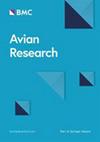在蒙面笑鸫中,系统发育的亲缘关系掩盖了声音的相似性来调节对不熟悉的蜂鸣声的反应
IF 1.7
2区 生物学
Q1 ORNITHOLOGY
引用次数: 0
摘要
对异种蜂鸣声的识别可以通过先天和习得两种机制发生,前者通常由两种主要假设来解释:声学相似性假设,强调共享声学特征;系统发育保守性假设,假设近亲物种可能共享先天解码模板。然而,尚不清楚系统发育亲缘性是否能单独驱动对陌生的蜂鸣声的识别,这一问题对理解种间交流和反捕食者策略的进化具有重要意义。本文通过对三种异域种拟笑鸫科鸣叫的回放实验,研究了其对陌生鸣叫的识别。结果揭示了两个关键发现:(1)蒙面笑鸫对不熟悉的鸣叫声表现出鸣叫反应,但强度明显低于同种鸣叫。(2)系统发育亲缘关系能显著预测群集强度,而不依赖于整体声学相似性。这些发现提高了我们对蒙面笑鸫等鸟类如何本能地识别其他物种的蜂鸣声的理解。我们表明,系统发育相关性而不是整体声学相似性可能是这种先天能力的关键。拥有共同祖先的物种可能具有相似的内置神经系统来解码警报信号。我们建议未来的研究需要结合神经生物学技术来确定遗传偏见和特征解码系统如何共同引导不同的鸟类群落感知异种的蜂鸣声。本文章由计算机程序翻译,如有差异,请以英文原文为准。
Phylogenetic relatedness overshadows acoustic similarity to regulate responses toward unfamiliar mobbing calls in Masked Laughingthrushes
Recognition of heterospecific mobbing calls can occur through both innate and learned mechanisms, with the former often explained by two main hypotheses: the acoustic similarity hypothesis, which emphasizes shared acoustic features, and the phylogenetic conservatism hypothesis, which posits that closely related species may share innate decoding templates. However, it remains unclear whether phylogenetic relatedness alone can drive the recognition of unfamiliar mobbing calls, a question with important implications for understanding the evolution of interspecific communication and anti-predator strategies. We examined the recognition of unfamiliar mobbing calls in Masked Laughingthrushes (Pterorhinus perspicillatus) using playback experiments with three allopatric species' mobbing calls of Leiothrichidae family. Results revealed two key findings: (1) Masked Laughingthrushes exhibited mobbing responses to unfamiliar mobbing calls, though at significantly lower intensity compared to conspecific playbacks. (2) Phylogenetic relatedness significantly predicted mobbing intensity, independent of overall acoustic similarity. These findings improve our understanding of how birds like Masked Laughingthrush instinctively recognize mobbing calls from other species. We show phylogenetic relatedness rather than overall acoustic similarity may be a key to this innate ability. Species that share a common ancestor may possess similar built-in neural systems for decoding alarm signals. We suggest that future research needs to combine neurobiological techniques to determine how inherited biases and feature decoding system together guide variable bird communities to perceive heterospecific mobbing calls.
求助全文
通过发布文献求助,成功后即可免费获取论文全文。
去求助
来源期刊

Avian Research
ORNITHOLOGY-
CiteScore
2.90
自引率
16.70%
发文量
456
审稿时长
46 days
期刊介绍:
Avian Research is an open access, peer-reviewed journal publishing high quality research and review articles on all aspects of ornithology from all over the world. It aims to report the latest and most significant progress in ornithology and to encourage exchange of ideas among international ornithologists. As an open access journal, Avian Research provides a unique opportunity to publish high quality contents that will be internationally accessible to any reader at no cost.
 求助内容:
求助内容: 应助结果提醒方式:
应助结果提醒方式:


